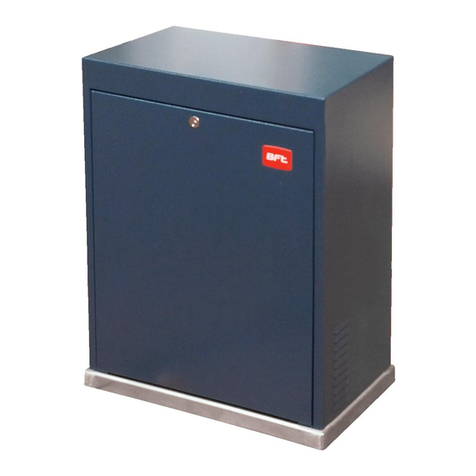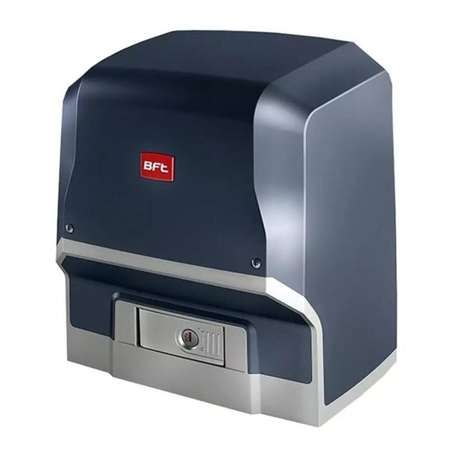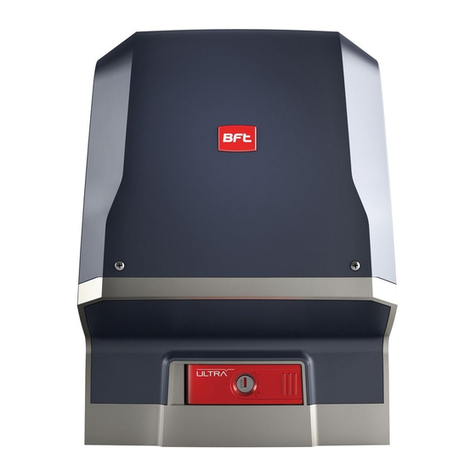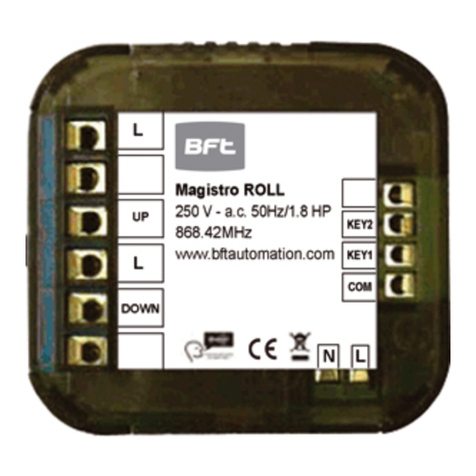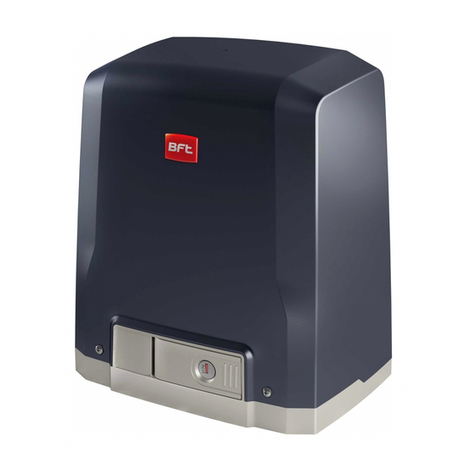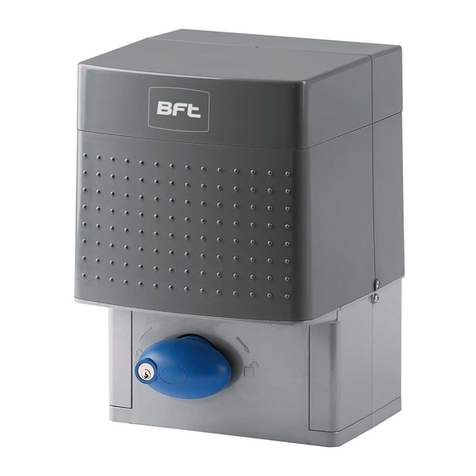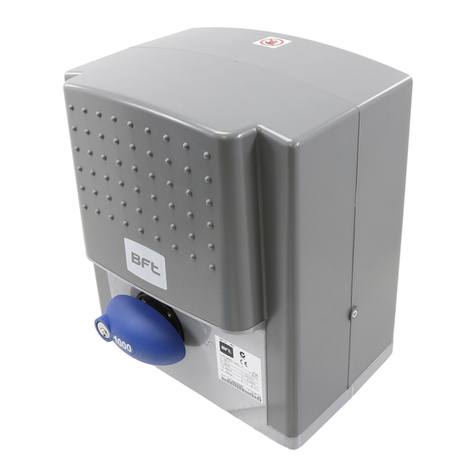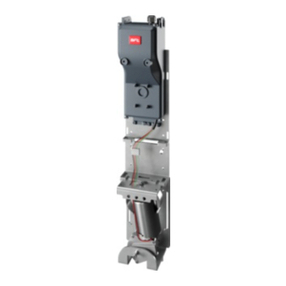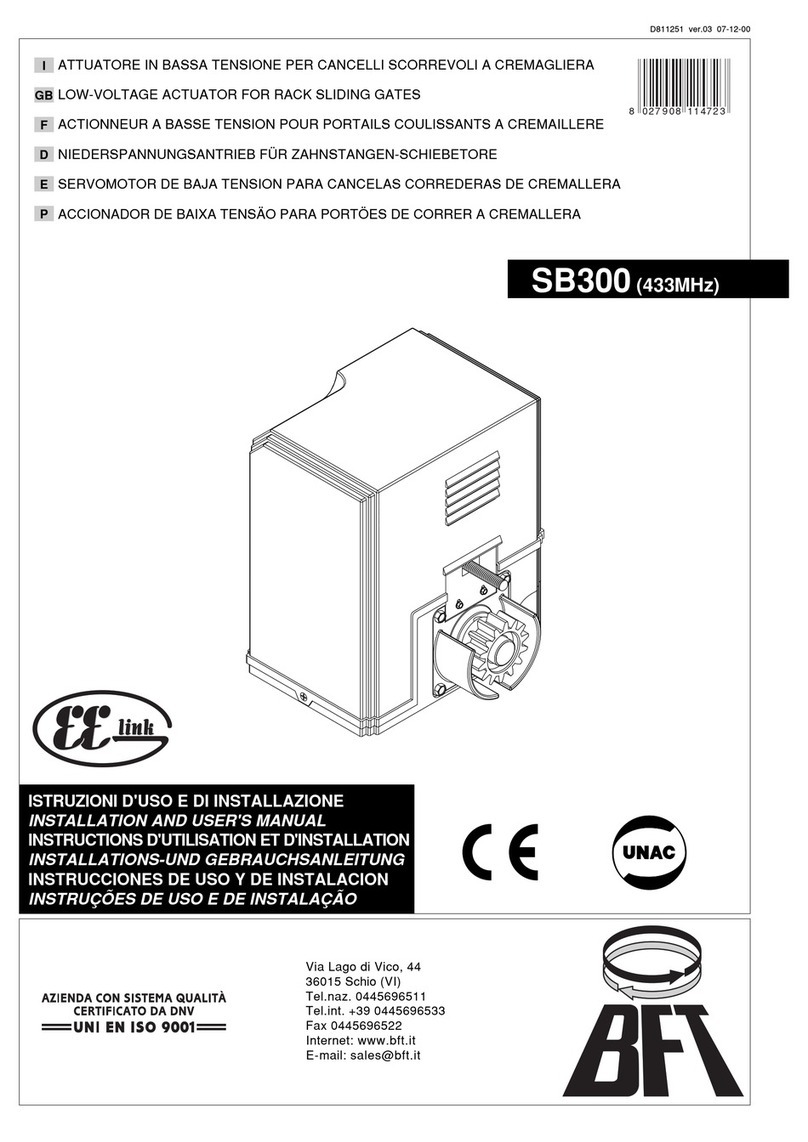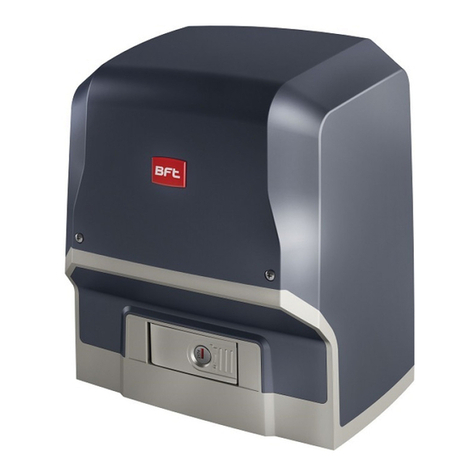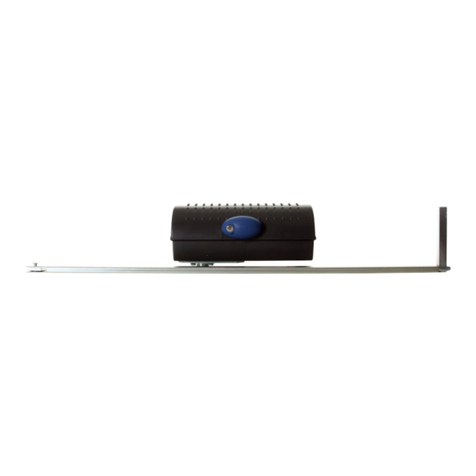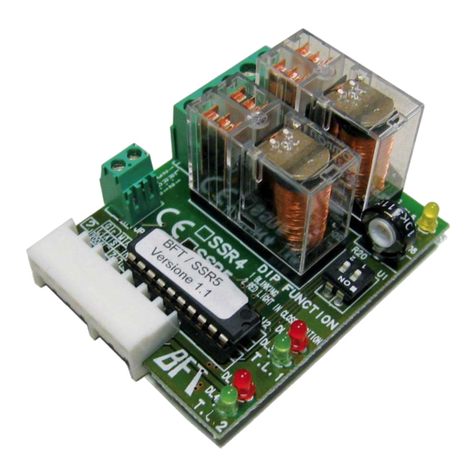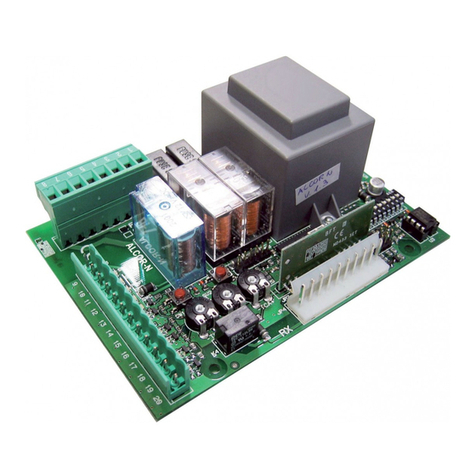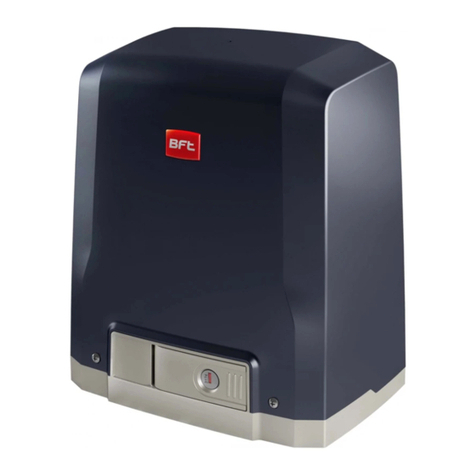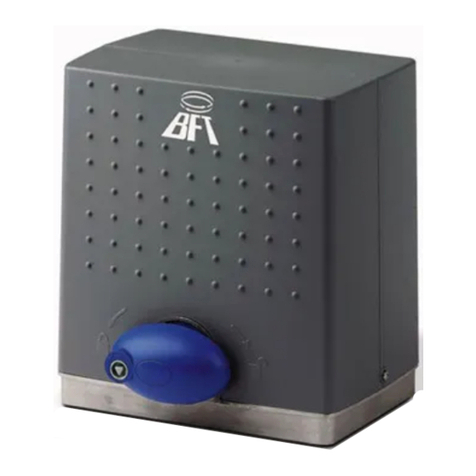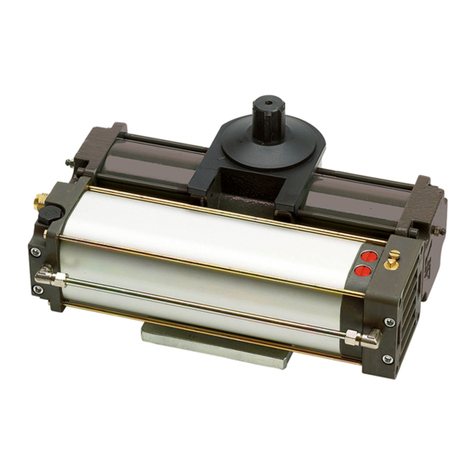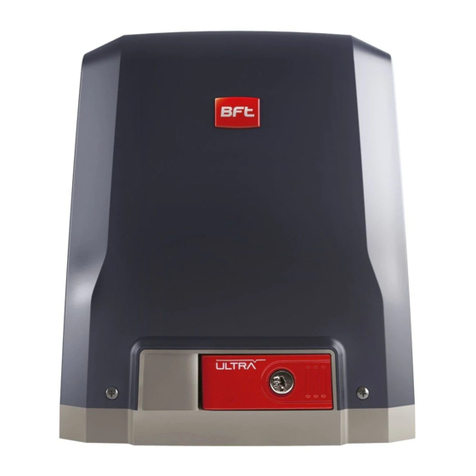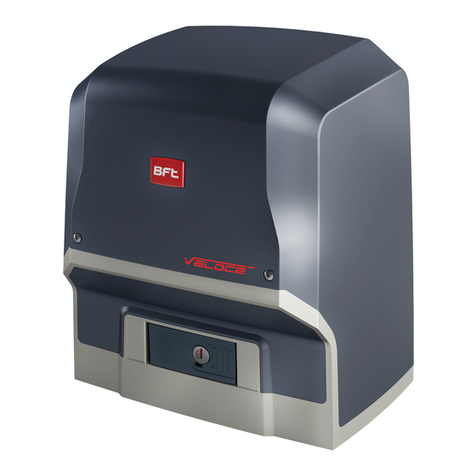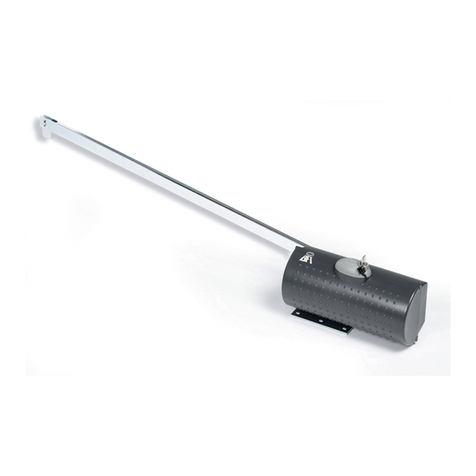MANUALE PER L’INSTALLAZIONE
ITALIANO
5) ANCORAGGIO DELLA PIASTRA BASE
5.1) Posizione standard
• Predisporreunoscavodoveeseguirelapiazzoladicementoconannegati
i tirafondi della piastra base per il fissaggio del gruppo riduttore (fig.3).
Se il binario di scorrimento è già esistente, lo scavo deve essere ricavato
in parte anche nel getto di fondazione del binario. In questo modo, un
eventuale cedimento del getto di fondazione del binario farà abbassare
anche la base del motoriduttore mantenendo così il gioco tra pignone e
cremagliera (circa 1-2mm).
• Posizionare la piastra base rispettando le quote riportate in fig.4.
Ilsimbolo del pignonestampigliatonellapiastra basedeveessere visibile
ed orientato verso il cancello.Ciò garantisce anche la corretta posizione
delle canalette per i collegamenti elettrici.
• Lasciare i tubi flessibili previsti per il passaggio dei collegamenti elettrici
sporgenti dalla piastra base .
• Per mantenere in posizione corretta la piastra base durante la posa in
opera, può risultare utile saldare due piatti di ferro sotto il binario sui quali
poi, saldare i tirafondi (fig.3).
• Eseguire un getto di calcestruzzo, facendo in modo che il getto della
piastra base faccia corpo unico con quello del binario del cancello.
• Controllare accuratamente:
Le quote di posizionamento.
Che la piastra base sia ben livellata.
Che i 4 filetti dei prigionieri siano ben puliti dal cemento.
Lasciare rapprendere il getto.
5.2) Altre posizioni
Il motoriduttore può essere posizionato in diversi modi. Nel caso il moto-
riduttore non venga fissato a livello del binario di scorrimento (Posizione
standard),sidevegarantireunsicurofissaggiodelmotoriduttoreinrelazione
anche alla posizione del cancello, in modo da mantenere un corretto gioco
(1-2mm) tra cremagliera e pignone. Deve essere garantito il rispetto delle
norme di sicurezza vigentiper quanto riguarda le persone,animali e cose, e
inparticolaredevonoessereevitatirischidiinfortunidovutiaschiacciamento,
nella zona di ingranamento pignone - cremagliera ed altri rischi meccanici.
Tutti i punti critici dovranno essere protetti da dispositivi di sicurezza
secondo quanto prevedono le normative vigenti
.
6) FISSAGGIO MOTORIDUTTORE
Quando il getto è indurito, osservando la fig.6 procedere come segue:
•
PosizionareundadoM10inognunodeitirantimantenendounadistanzadalla
basedialmeno25mmperpermetterediabbassareilmotoriduttoreadinstallazio-
ne ultimatao per aggiustamenti successidelgioco tra pignone ecremagliera.
• Posizionareunpiatto“P”indotazioneinognicoppiaditirantieconl’ausilio
di una livella, regolare il piano nei due sensi.
•
Togliere il cofano ed i due carter copriviti al motoriduttore, e posizionare il
gruppo riduttore nei quattro tiranti con il pignone rivolto verso il cancello.
• Posizionare i due piatti P superiori (Fig.6) e avvitare i quattro dadi di
bloccaggio del motoriduttore.
• Regolarelaprofonditàdelmotoriduttorefacendoloscorrerenelleapposite
feritoieprevistenellabaseefissarloadunadistanzatrapignoneecancello
adeguata al tipo di cremagliera da installare. I denti della cremagliera
devono ingranare nel pignone per tutta la loro larghezza.
Al paragrafo “Montaggio della cremagliera” riportiamo le misure ed il
modo di installazione dei tipi più diffusi di cremagliera.
7) MONTAGGIO DELLA CREMAGLIERA
Al cancello, deve essere fissata una cremagliera con modulo denti m=4.Per
quanto riguarda la lunghezza, questa deve contemplare, oltre alla luce del
passaggio,ancheilfissaggiodellestaffeperl’azionamentodeimicrofinecorsa
e la parte di ingranamento del pignone. Esistono diversi tipi di cremagliera,
ognunodeiqualisidiversificaperlaportataedilmododifissaggioalcancello.
La Ditta commercializza tre tipi di cremagliera che sono:
7.1) Mod. CFZ (Fig.7).
Cremaglieradiferrozincatosez.22x22mm-fornitainpezzida2metri-portata
oltre i 2000kg (≈20000N).Questi pezzi devono essere, prima saldati ad un
adeguato angolare di ferro e poi il tutto, saldato al cancello.L’angolare, oltre
a mantenere la distanza fra la cremagliera ed il fianco del cancello, agevola
la fase di fissaggio al cancello stesso, anche se questo ha dei leggeri sban-
damenti laterali.Nelle saldature di giunzione dei vari pezzi di cremagliera, si
consigliadidisporreunospezzonedicremaglieracomein(fig.8)pergarantire
il passo corretto per tutta la lunghezza della cremagliera.
7.2) Mod. CPZ (Fig.7).
Cremagliera di plastica - sez. 22x22mm - fornita in pezzi da 1m - portata
max.500kg(≈5000N).Questo modello vafissatoalcancello convitinormali
o autofilettanti.È opportuno anche in questo caso, interporre uno spezzone
al contrario nella giunzione tra i vari spezzi in modo da mantenere il passo
correttodei denti.Questo tipo dicremagliera,èpiùsilenziosa e permettere-
golazioni in altezza anche dopo il fissaggio, per mezzo di feritoie previste.
7.3) Mod. CVZ (Fig.7)
Cremaglieradiferrozincatosez.30x12mmfornitainpezzida1m-distanziali
filettati a saldare - portata max. 2000kg (≈20000N).
Fissati i distanziali in centro ad ogni asola dei vari pezzi di cremagliera, sal-
darei distanziali al cancello.Anche in questo caso, sistemare uno spezzone
al contrario nei punti di giunzione dei vari pezzi di cremagliera per garantire
il passo corretto dei denti. Le viti che fissano la cremagliera ai distanziali,
consentono regolazioni in altezza della cremagliera.
7.4) Fissaggio della cremagliera
Per il montaggio della cremagliera, eseguire quanto segue:
• Attivarelosbloccodiemergenzaruotandol’appositamanopoladisblocco
(Vedere paragrafo “Manovra di emergenza”).
• Appoggiarel’estremità dellacremaglierasul pignonedicomando edese-
guire il fissaggio (con saldatura o con viti) in corrispondenza del pignone
facendo scorrere manualmente il cancello (fig.9).
• Nel caso di cancello irregolare (eccessiva curvatura laterale), se non è
possibile correggerla, bisogna interporre degli spessori fra cremagliera
e cancello in modo da garantire sempre il centraggio della cremagliera
rispetto al pignone (fig.10).
PERICOLO-L’operazionedisaldaturavaeseguitadapersonacapacee
dotata di tutti i dispositivi di protezione individuali previsti dalle norme
di sicurezza vigenti.
8) REGOLAZIONE PIGNONE
Terminatoilfissaggiodellacremaglieraènecessarioregolareilgiococrema-
gliera-pignonechedeveesseredicirca2mm(fig.6):ciòsiottieneallentando
per circa 2mm, i quattro dadi M10 sotto la base del motoriduttore e fissando
poi i quattro dadi superiori. Assicurare l’allineamento ed il centraggio della
cremagliera - pignone (fig.10).
ATTENZIONE- Ricordarsichela duratadella cremaglieraedel pignone
dipendono in modo determinante dal corretto ingranamento.
9) FINECORSA ELETTROMECCANICI
L’operazionevaeseguita con sbloccodiemergenzaattivatoe senzaalimen-
tazione di rete. I pattini che comandano i finecorsa vanno posizionati alle
estremità della cremagliera.
- Spingere manualmente il cancello in completa apertura.
- Posizionare il pattino finecorsa di apertura (fig.11) in modo che intercetti
la leva di comando del micro e che lo facciano scattare. Individuata la
posizione corretta, serrare le viti del pattino.
- Spingere manualmente il cancello in completa chiusura.
- Posizionare il pattino finecorsa di chiusura (fig.11) in modo che intercetti
la leva di comando del micro e che lo facciano scattare.
Individuata la posizione corretta, serrare le viti del pattino.
- Ipattini,devonobloccareilcancello,primachequestointercettiifermid’arresto
meccanici postisullarotaia.Laregolazionedelpattinofinecorsadichiusura
deveesserefattainmododalasciareunfrancodicirca50mmfrailcancello
ed il battente fisso, come previsto dalle norme di sicurezza vigenti oppure,
applicare una costa sensibile di almeno 50mm di spessore (fig.12).
10) FERMI D’ARRESTO
PERICOLO - Il cancello deve essere dotato dei fermi d’arresto mecca-
nici sia in apertura sia in chiusura, in modo da impedire la fuoriuscita
del cancello dalla guida superiore (fig.13);devono essere solidamente
fissati a terra, qualche centimetro oltre il punto d’arresto elettrico.
11) PREDISPOSIZIONE IMPIANTO ELETTRICO
Predisporre l’impianto elettrico come indicato in fig.14 facendo riferimento
allenormevigentipergliimpiantielettriciCEI64-8,IEC364,armonizzazione
HD384 ed altre norme nazionali.
ATTENZIONE! Per il collegamento alla rete,utilizzare cavo multipolare
disezione minima3x1.5mm2e deltipo previsto dallenormative vigenti.
A titolo di esempio, se il cavo è all’esterno (all’aperto), deve essere
almenopariaH07RN-Fmentre,seall’interno(incanaletta),deveessere
almeno pari a H05VV-F con sezione 3x1.5mm2.
Realizzareicollegamentideidispositividicomandoedisicurezzainarmonia
con le norme per la tecnica degli impianti precedentemente citate. Tenere
nettamente separati i collegamenti di rete dai collegamenti in bassissima
tensionedisicurezza.Iconduttoriin24Vdevonoesserefisicamenteseparati
oppure adeguatamente isolati (isolamento di 1 mm) dagli altri conduttori.
In fig.14 è riportato il numero di collegamenti e la loro sezione per una
lunghezza di circa 100 metri; per lunghezze superiori, calcolare la sezione
per il carico reale dell’automazione.
I componenti principali per una automazione sono (fig.14):
IInterruttore onnipolare omologato di adeguata portata con aper-
tura contati di almeno 3,5 mm provvisto di protezione contro i
sovraccarichi ed i corti circuiti, atto a sezionare l’automazione
dalla rete.Se non presente, prevedere a monte dell’automazione
un interruttore differenziale omologato con soglia 0,03A.
QR Quadro comando e ricevente incorporata
SSelettore a chiave
AL Lampeggiante con antenna accordata
MAttuatore
PPulsantiera a muro
Fte, Fre Coppia fotocellule esterne
TTrasmittente 1-2-4 canali
CCremagliera
INSTALLAZIONE ANTENNA
Usare una antenna accordata sui 433MHz.
Per il collegamento Antenna-Ricevitore usare cavo coassiale RG58.
La presenza di masse metalliche a ridosso dell’antenna, può disturbare la
ricezioneradio.Incasodiscarsaportatadeltrasmettitore,spostarel’antenna
in un punto più idoneo.
